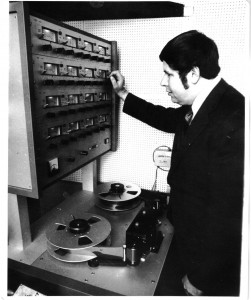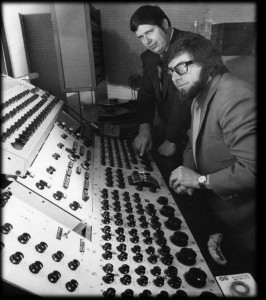By July 1969 Optronics had grown beyond what could be achieved working in his spare time in a back-yard shed, so Graham left Rola/Plessey to turn Optronics into a full-time concern.
He moved the business into a factory building and started assembling the machinery necessary for the precision mechanical component manufacture that was going to be needed for his next project – studio tape recorders.
Here he received much advice and practical help from his machinist father, who contributed significantly to the mechanical excellence of the design.
Graham’s broad knowledge and skill-set was vital to this venture, with electronics, mechanicals, electromechanicals, and servo-systems design all being critical elements of the tape recorder design.
As in his days at Byer/Rola, almost all of the parts for Optro recorders were manufactured in-house to ensure rigid quality control.
He is quoted as having said that they “made everything except the heads”.
Mono, stereo and four-track versions of his Optro design were later purchased in significant numbers by the ABC.
The Optro machines were the first to incorporate a crystal-locked servo driven capstan motor, which resulted in significantly improved wow and flutter performance. It was an innovation later adopted by most other tape machine manufacturers. This advance also permitted the inclusion of an integrated varispeed function in the machines. Previously, synchronous capstan motors were used, which are speed-locked to the mains frequency. To vary the speed of such motors, a cumbersome (and expensive) external power amplifier and oscillator needed to be employed. Consequently until the Optro 1000 series (and its inevitable imitators) the varispeed function was not widely available to recording engineers and producers.
In June 1971 the first Optro1000 16Track recorder was finally delivered to Bill Armstrong Studios.
This is claimed to be the first 16Track recorder used in Australia.
Bill Armstrong recalls that Graham was a perfectionist, and was always holding back his products’ delivery for that one last improvement or tweak – but that when delivered they worked superbly.
The “sixteen tracks across a two inch tape” format required a high level of tolerance in deck precision and stability, as well as tape handling. The excellent performance of these machines was a tribute to Graham’s electro-mechanical as well as electronic design and manufacturing skills.
Later a 24Track machine was designed and built and, naturally, Bill Armstrong’s studios again benefited from this ground-breaking initiative.
As well as the tape recorders, Graham and “Optro” continued to develop advanced audio consoles and outboard equipment – providing equipment to studios and broadcasters across Australia. A 1973 article in the media industry weekly B&T reports on the new 2SM Sydney studios and refers to Otpro mixing desks in their on-air studios.
In a newspaper article in 1971 profiling Graham in the wake of the new 16-track recorder installed at Armstrongs, Graham was quoted as saying (rather ruefully) that “certain aspects of most our work would be patentable at the moment – but a lot of people rely heavily on reading patents to get new ideas”.
This, together with the amount of money, attention, and time needed to lodge, and then defend patents, caused Graham to sometimes rely on what has been called the “Epoxy Patent” – where critical circuitry was kept secret by being potted in epoxy, and the circuit not published in the equipment schematic; to thwart “reverse engineering”.
He was not the only inventor to resort to such intellectual property protection, with it being a not uncommon practice in the ‘60s and ‘70s when audio and control mathematical functions were realized in hardware not software.
In 1974 the world started to change with the release of the first truly “personal” computer, the Altair 8800. It was a true hardcore electronics enthusiast’s device, sold as either a kit or fully assembled, and featured in the pages of the US “Popular Electronics” magazine.
Graham immediately saw the potential and purchased one and started to teach himself programming. He also saw the potential when the Apple II was launched in 1977, and soon had one of those as well, writing programs for acoustic design work on the Apple.
<Previous Page Page 3 of 5 Next Page>
Links to other pages:
The Rola Days 1 – Graham’s photos. The Rola Days 2 – The Magnetic Drum products.


